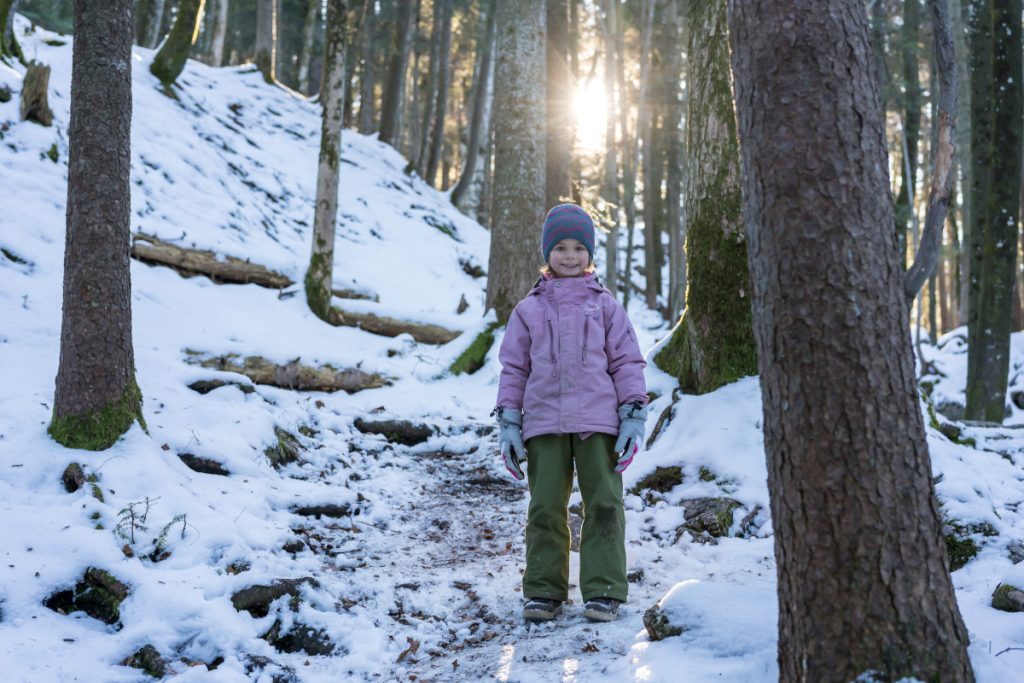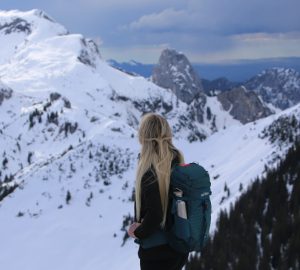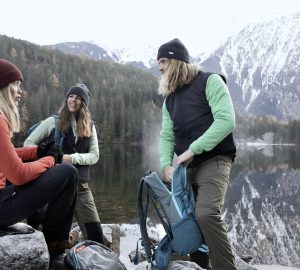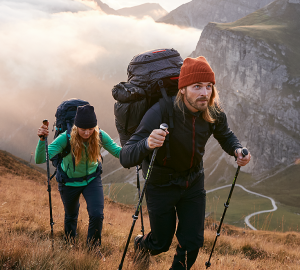Winter hiking with children. Is that even possible? It’s definitely possible and even very good, because most children love snow. There can hardly be a better motivation than the white splendor. If only it wasn’t so cold.
I get out of the warm car and take a deep breath. All around me is a snow-covered mountain landscape, the air is clear and freezing cold. It promises to be a wonderful day of winter hiking. However, my two children in the back seat are not exactly cheering with enthusiasm. They don’t like the cold and the clothes we have to put on and the nagging starts before we’ve even set foot in front of the other. Snow or no snow.
As a family, we’ve been winter hiking with children countless times. So we’ve successfully got them out of the back seat and into their winter clothes. I have written down my experiences and tips for hiking in the cold season for you below. So you can start your winter hiking adventure well prepared.
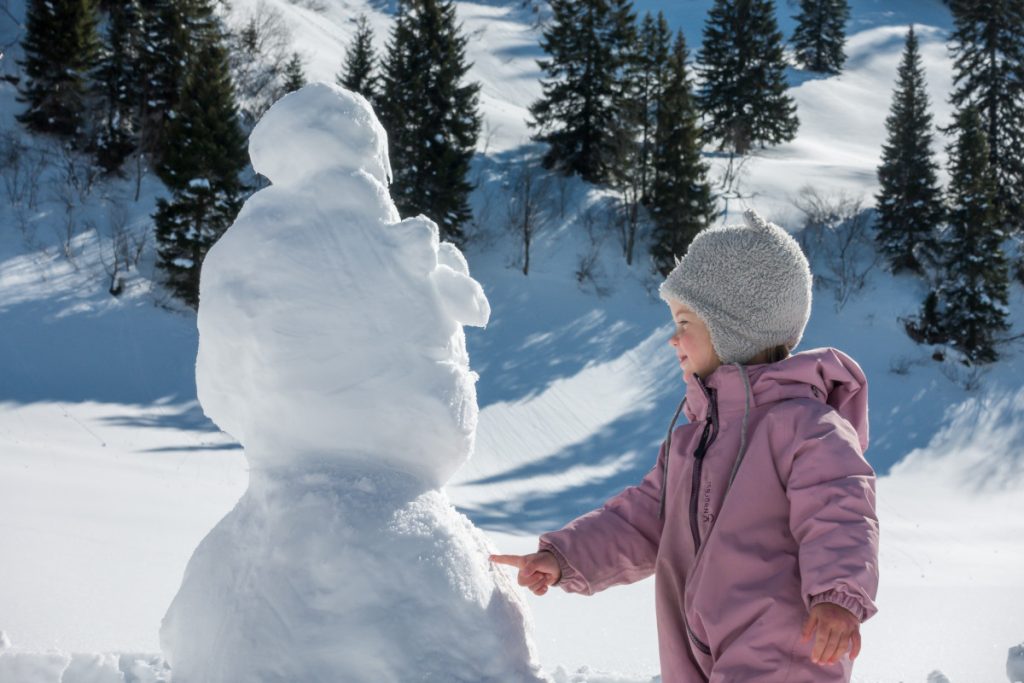
Winter hiking with children: Before you set off
The right tour planning
No matter what time of year you go hiking with children, the most important thing is to plan your tour in advance. The good news is that planning a tour in winter is relatively easy. While you need exciting hiking trails without snow so that the children don’t get bored, snow-covered forest trails are almost a must in winter. Especially if you are taking a sledge with you.
The following tips will help you find a suitable tour:
Brevity is the spice of life: Hiking through or on snow is strenuous. In winter, the days are also short and no matter how much we move, the cold usually manages to cool us down at some point, starting with our toes and fingers. Short tours are therefore a good choice.
Keep it simple: in summer, hiking trails can’t be adventurous enough to motivate you. In winter, easy tours are perfectly adequate. Snow-covered forest paths and access roads are perfect for winter hikes with children. They usually have a slight incline, so the ascent is easy and they are not really challenging. If your children are older and enjoy hiking with micro spikes or snowshoes, you can of course adapt the tours accordingly.
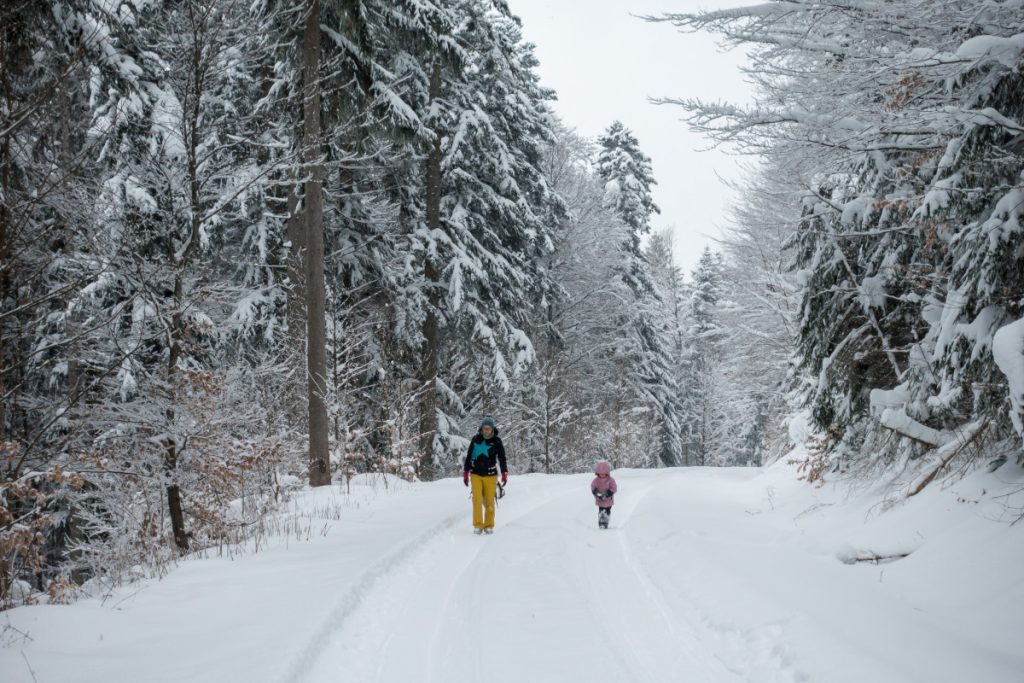
Chasing the sun: When planning your tour, make sure you are facing south. If the sun is shining, you can enjoy it for a particularly long time. Especially in winter, every ray of sunshine is a real boon for our immune system and our well-being.

Huts without winter sleep: There are huts that are open all year round and these are great for winter hiking with children. After a warm soup and with warmed toes and fingers, the good mood of all family members is quickly restored.
A little pro tip: never trust that you will actually get into a hut. On popular hiking trails, we have stood in front of closed doors with the notice “Closed due to overcrowding”. Fortunately, we had enough provisions and warm drinks with us.
Sledging downhill highlight: Plan a hike so that you can whizz back downhill on your sledge. Because no matter how you twist and turn it: The sledge run is the real winter hiking highlight for children.
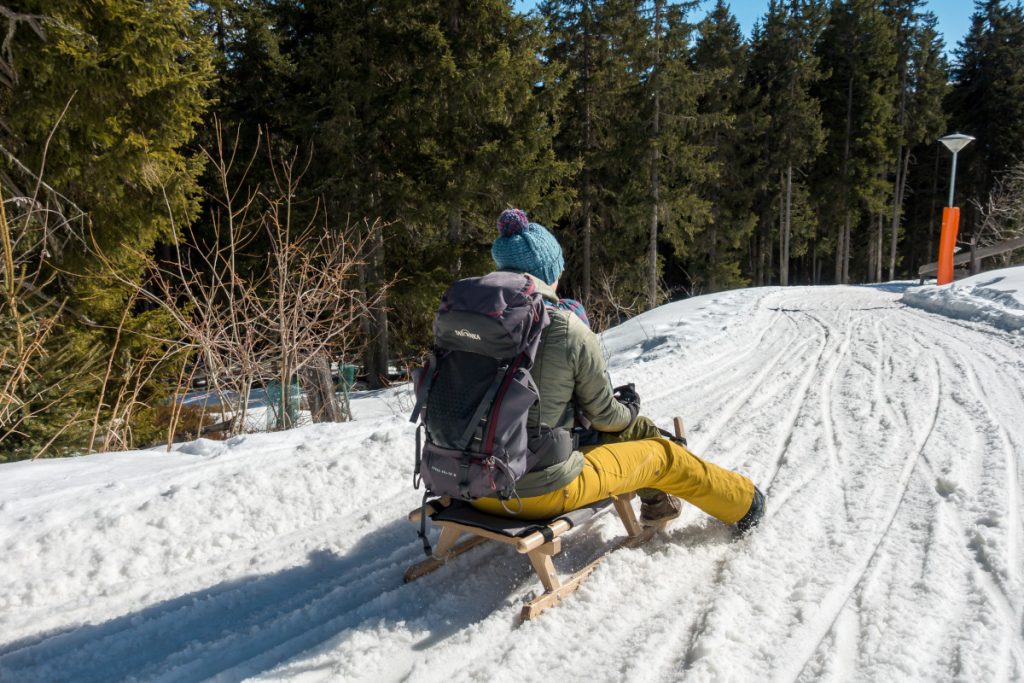
The thing with the sledge
Winter hiking with children without a sledge is somehow unthinkable, because the real highlight for the little hikers is not the pleasantly clear air, the beautiful winter landscape or the crunching of the snow under their shoes. No, it is and remains the ride on the toboggan. However, if we have the sledges with us, it is difficult to motivate the children to go hiking, as they much prefer to sit on them. Quite apart from the fact that they get cold far too quickly, it is simply incredibly tiring to pull a child up the mountain on a sledge. For this reason, we don’t always have the “real sledges” with us in winter, but snow slides. We simply clip them to the outside of the rucksack and each child then has their own little sled on the descent, as these things are relatively easy to control.
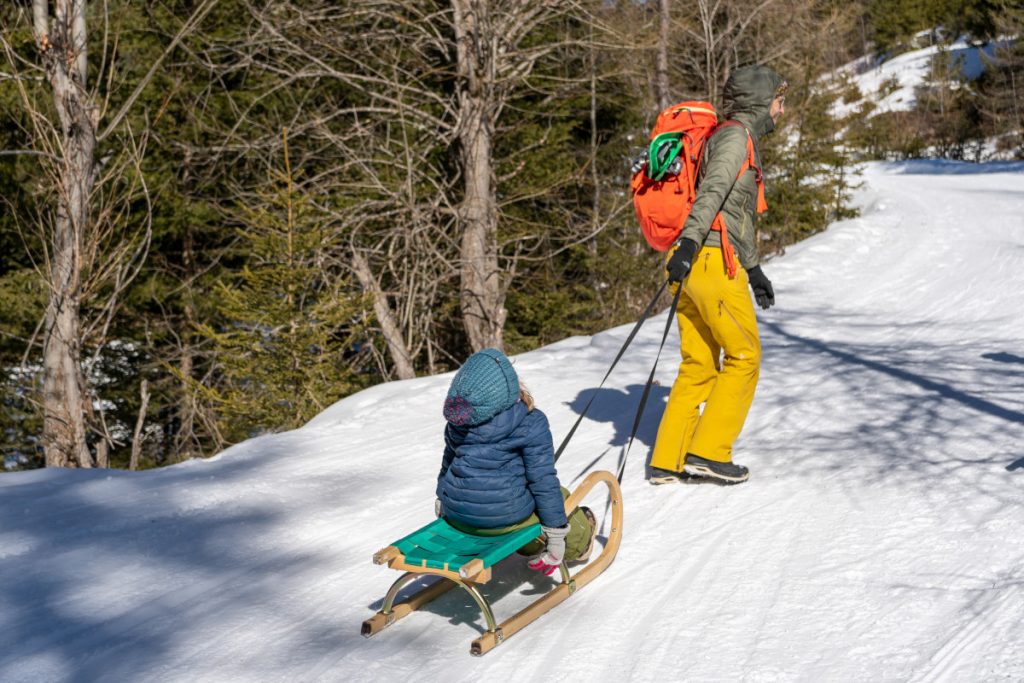
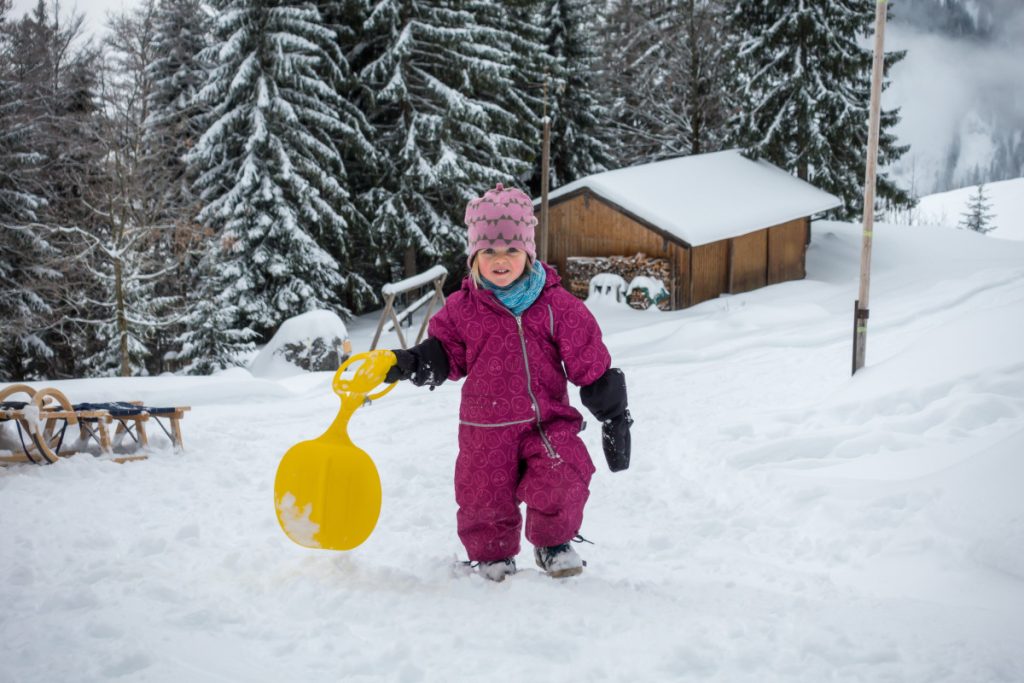
The right equipment
The right equipment is essential for winter hiking with children. Snow and cold are always a challenge, even on easy and short tours.
Clothing
In winter, dress like an onion (layered clothing principle). In other words, several suitable layers on top of each other, which can be put on and taken off as required. How many layers your children need depends very much on how much they move around and how much they tend to freeze or sweat. For your own layers, remember that you won’t be moving as quickly with children and the cold will therefore have a good chance of driving away your inner warmth. If, on the other hand, you’re pulling your child and sled up the mountain, you’re sure to get really warm.
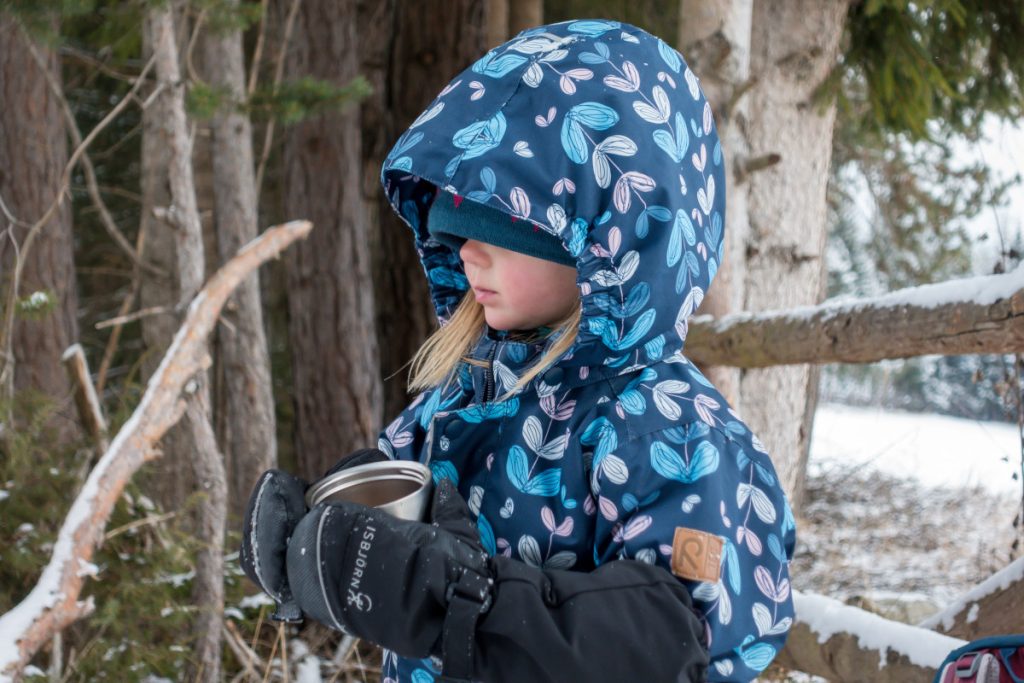
The thing with the layered clothing principle
This is a little reminder to all parents who dress their children in several layers, but then like to deny them their own body awareness when out and about. If the children are warm, they should also be given the opportunity to take off a layer or at least be allowed to open their jacket, because that’s exactly why they are dressed like an onion. I know that we parents find it incredibly difficult to allow them to take off their jacket for a while when it’s cold. But I also know that everyone, including children, has a very different perception of cold.
I recommend that you dress your children in two to three layers in winter. But always bear in mind that too much clothing makes them immobile and clothes that are too big are annoying. This will quickly put an end to the children’s hiking fun.
- The first layer: The first layer consists of ski underwear in the form of a thin longsleeve and leggings. Opt for natural materials such as merino wool or a silk-wool blend, as these regulate body temperature and moisture best.
- The second layer: On very cold days or for small children, a second layer can make sense. The focus here is on comfort. Go for jogging trousers and a fleece jacket.
- The last layer: The last layer consists of a snowsuit or a winter jacket combined with snow pants. It is clear that this layer must be absolutely waterproof. The higher the so-called water column, the better. This means that even small polar bears can roll around in the snow for a very long time without moisture having a chance.
- All the trimmings: Good winter clothing also includes a suitable hat, scarf and thick socks. Also good, waterproof gloves and sunglasses.
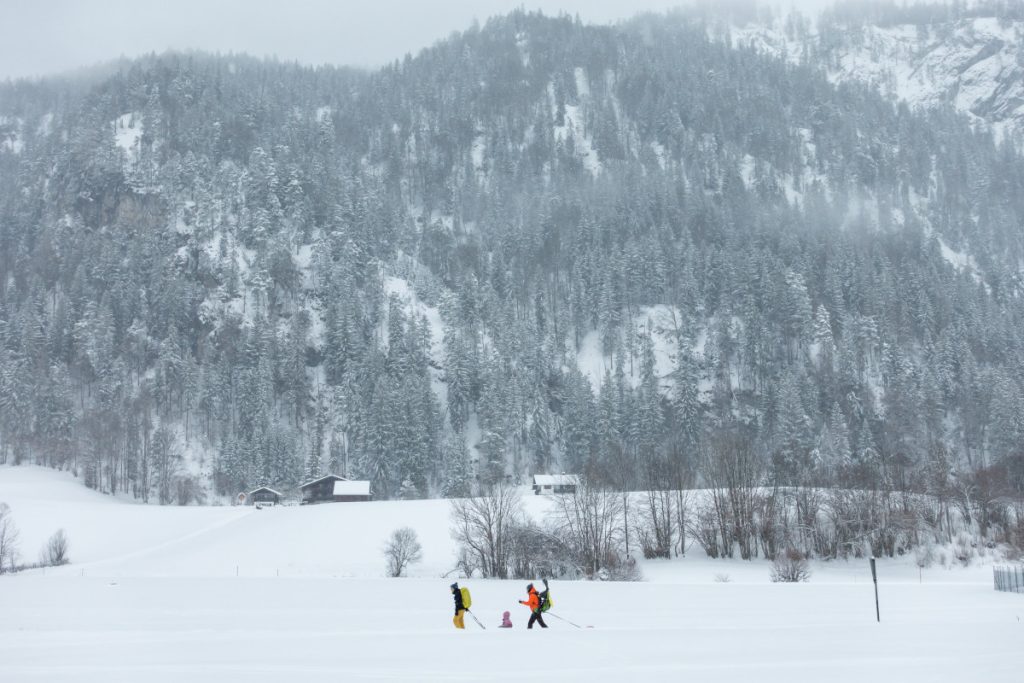
With these tips, you’ll be well equipped and ready to set off on your winter hike with children. But isn’t there something else missing? That’s right. The shoes.
Footwear
The right shoes are also important for a winter hike with children, because cold and wet feet can quickly put an end to the fun. When choosing shoes, make sure they are waterproof and warmly lined. A waterproof and breathable Gore-Tex membrane and insulating lining are a good choice here. A good sole ensures a stable grip and a high shaft keeps children’s feet warm for longer.
Micro spikes
If there has just been a lot of fresh snow, then winter hiking is a fine or soft thing. However, you really don’t know what to expect on a hike in the cold season. Thawed, refrozen and heavily used paths can sometimes be very hard and slippery or even slippery as glass. This makes hiking extremely difficult.
We take micro spikes (so called Grödel) with us on every winter hike with children. Thanks to their prongs, micro spikes ensure a stable grip in the snow or on icy ground. Children who are already confident hikers and have appropriately sized shoes can also use micro spikes. The micro spikes themselves are simply pulled over the shoes, they take up little space in the hiking pack and are very lightweight.
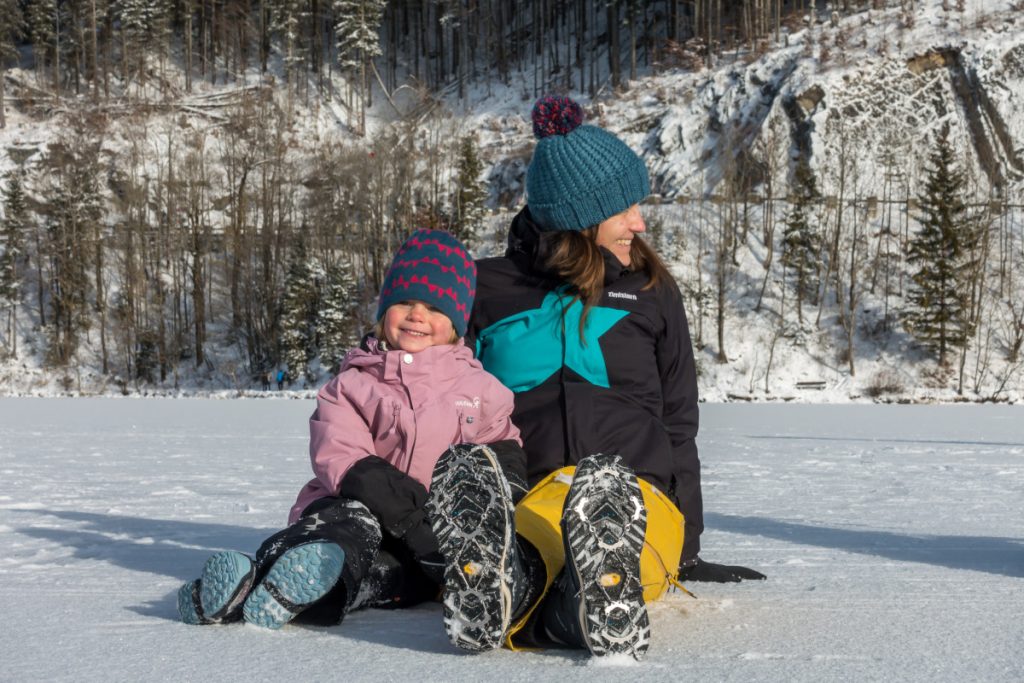
Winter hiking with children: A packing list
- Touring backpack or hiking backpack
- Change of socks
- Second pair of gloves
- Sun cream
- A cold cream
- Sufficient hiking provisions and snacks.
My tip: Hot soup is great to take with you in a thermos flask. - Thermos flask with hot drinks in the form of tea or warm juice / children’s punch
- Micro Spikes
- Pocket warmer
- Thermal seat pad / seat cushion
- First aid kit
- Handkerchiefs
- Bottom slider
- Rain cover for the backpack
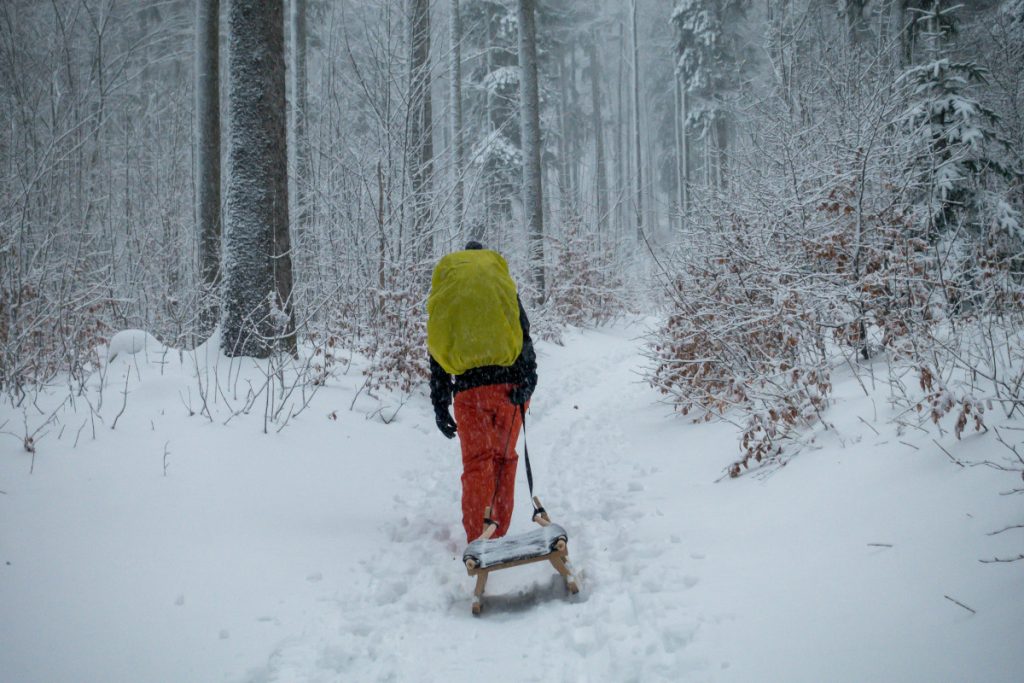
At this point, I would also like to mention the nerves of steel that you should definitely pack. Because winter hiking with children can definitely be a bit exhausting. My children, at least, don’t always trudge up the mountain in a good mood and without taking a break. Gloves have to be taken off and put on again, snacks rummaged for, noses wiped, drinks poured, sledges pulled, arguments settled and hiking lows bridged.
Winter hiking with children: On the road
The thing with the cold
The nature of winter hiking with children is that it is cold. But it’s really rarely “too cold”. It’s up to us adults to make sure that the children stay dry and warm thanks to the right clothing. We are also responsible for a never-ending source of hot tea or children’s punch and for keeping our children warm inside.

Warmth from the inside is really important when you’re out and about, because it’s the only way to avoid getting cold on a winter hike. And where does the warmth come from inside? Through sufficient exercise. So avoid long breaks and take lots of short breaks instead. If there is a break, encourage the children to play games. How about a snowball fight or a snowball throwing competition.
Small children who spend a lot of time sitting on a sledge or in a child carrier should also be wrapped in a footmuff or carrying cover, as experience has shown that they otherwise cool down too quickly. It is important that we adults also make sure that we don’t get too cold, because depending on the age and urge to play of the children, we hike very slowly and easily get cold.
Motivating children to hike in winter
Are your children having a bit of a lull during winter hiking? Then they need a little motivational kick. Very often, “I can’t walk any more” simply means “I’m bored”. Such a hiking slump can be bridged with distraction.
Reading tip: Motivating children to hike – the best tips and tricks
In winter, the snow provides plenty of hiking variety. How about a snowball fight on the way? Or keeping an eye out for animal tracks? My city kids are still blown away when we find deer tracks. Freshly snow-covered trees with low-hanging branches make for great sleet and icicles taste better than any lollipop. The search for them will take you a few meters further. In winter, I also like to start a “challenge” about who is fastest on the sledge on the way back from us. The prospect of a warm hut with delicious food can usually activate the last reserves of energy. True to the motto: the destination is the journey.
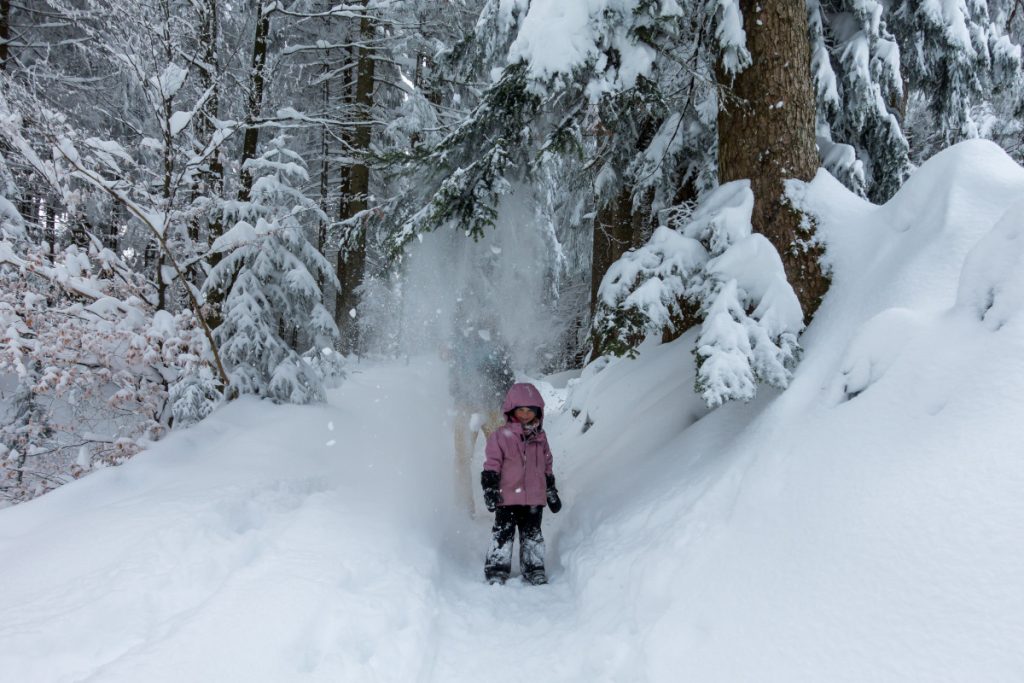
Winter hiking with children is a great thing and anyone who has the opportunity to go out into the snow in winter should not miss out on these hours in the fresh air. For us, they are an important counterbalance to the many hours spent indoors in winter.
Have fun in the snow with your children.
